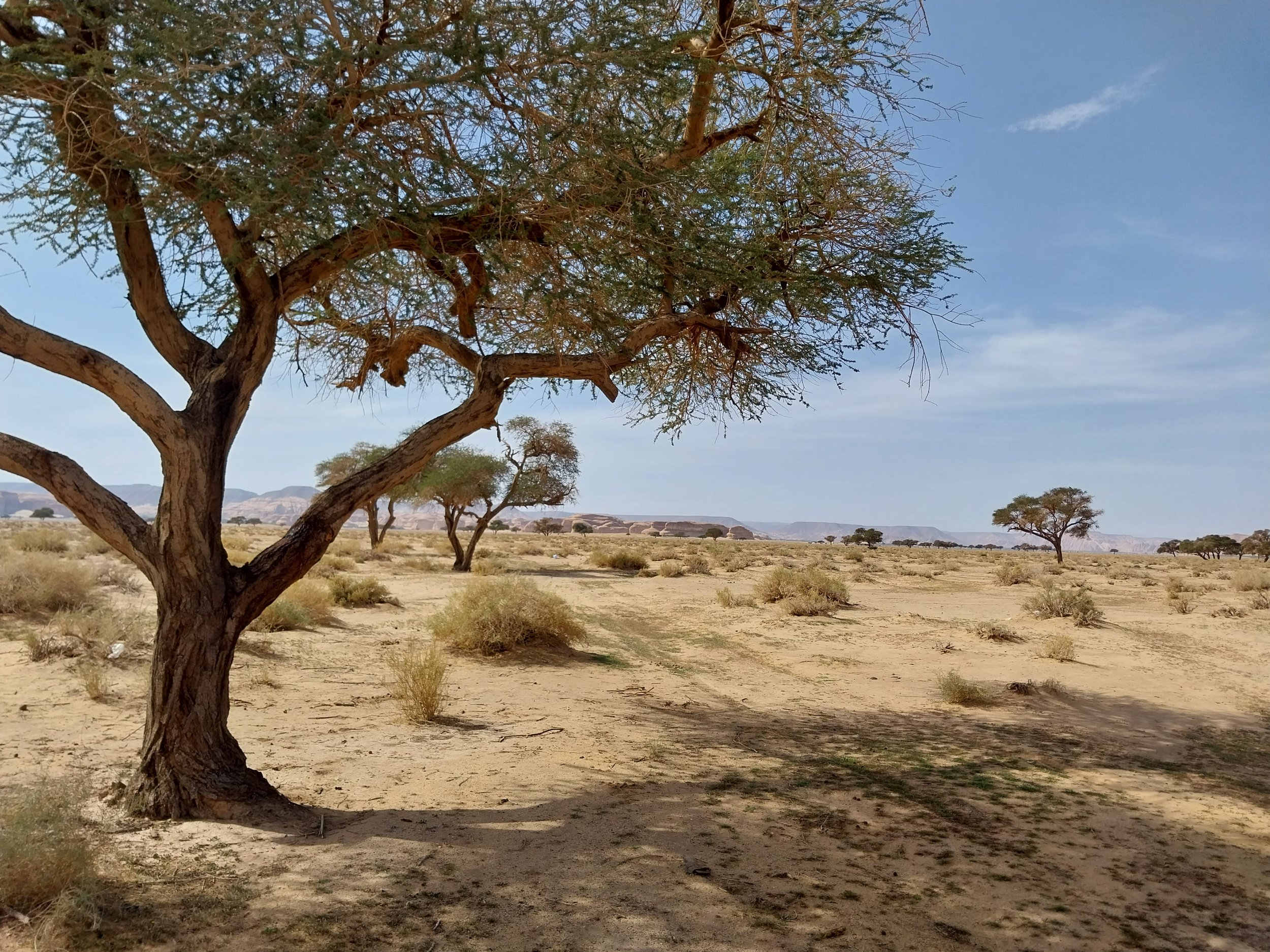“We will go to the Hidden Valley,” said Hasan, the County Manager for Husaak Adventures, as we drove north through AlUla.
We passed the incredible UNESCO World Heritage Site of Hegra, a place where tombs are carved deep into large sandstone outcrops. And then on our left, a scene like something taken out of the savannah in Africa, a sandy plain with beautiful Acacia tress providing some stunning photography opportunities. The road was straight, and in the distance spectacular natural formations rose, as if we were travelling on another planet.
Whilst we chatted, I thought about the name Hidden Valley. It had a sense of adventure to it. It reminded me of films I saw when I was younger, places where dinosaurs still roamed. I know that dinosaurs are still with us today, although very different from their enormous, fearsome relatives. And I did see some on the drive: hooded crows squawking at each other, desert larks flitting from shrubby bush to shrubby bush, and I even saw an eagle perched at the top of one of the photogenic Acacia trees, and effortlessly glide to another one nearby.
This was AlUla. The beautiful landscape. The spectacular wildlife. And we were off to explore the Hidden Valley.
We arrive at the edge of Sharaan, one of AlUla’s five nature reserves. Each place in AlUla has its own feel, its own atmosphere. A feeling created by the landscape, by the geology. And Sharaan is no exception. Parking on the sand, we step out. We are surrounded by large light brown rocks, towering above us. It is a different feel from the hustle and bustle of being surrounded by tall buildings in a city. You feel the calmness of being surrounded by silence. A few small birds singing. The warmth of the sun on your face. It is a different kind of beauty encapsulated by the rocks around you.
Fortunately, the Hidden Valley is not full of dangers, rampant with roaring dinosaurs, or terrifying terrains. It is a beautiful, short circular walk on the very edge of the Sharaan Nature Reserve.
We start our walk near a dozen or so khaki coloured tents, fitting into the environment nicely. These are set up for groups to come and camp and enjoy the quiet of AlUla. The trail is a part of this camp site, for the campers to enjoy and leisurely take in beautiful surroundings.
The rocks surround us. Huge outcrops of 500 million year old sandstone, soaring above us. They are dark brown in places, almost as if they have been splattered with paint. This is something called desert varnish, and it is a common sight on the rocks in AlUla. The wind carries tiny clay particles which hit the rock and stick to it. When these clay particles have manganese in them, they give a brown colour, and when they have more iron in them, they give a redder look. The desert varnish can be seen on the rocks around the trail; for hundreds of years, natures painters have been working hard.
Red and brown stripes down the rocks in front, and darker splatters on the rocks to the left, desert varnish is nature’s painter.
There are shrubs too, lots of different species of shrubs. We crouch down alongside the white saxaul (Haloxyon persicum), a small shrub that looks so different to any shrub you may have seen. The leaves, are long and thin, almost like green branches. This is a pretty nice adaptation for a shrub that lives in the desert, extremely thin leaves so they don’t lose moisture in the heat of the desert, and they like to live in sandy soils. There’s another thorny bush close by, the thorn tree (Vachellia sp.). These are extremely well protected from grazing animals with dangerously big thorns so that any animal trying to eat them will get a very big shock!
We carry on our walk. We spot animal tracks in the sand. Wolves, lizards and birds have all recently walked here. It’s so peaceful. We walk in silence for some minutes, before saying to each other how beautiful the silence is. Husan loves the outdoors. He is passionate about nature and it’s obvious how his enthusiasm is passed on to anyone on his tours. Stepping over the sand, we talk about the real value of just being outside, in the outdoors. No internet. No meetings. Just you and the natural beauty all around you. It is calming, and so good for a person’s wellbeing.
The grey basalt rocks stand out against the light brown sand.
Just before arrive at the Sharaan Nature Reserve, the beautiful landscape reminiscent of the African Savannah.
Another familiar sight is tafoni. These are pits in the rock that look like holes or sometimes burrows. They form naturally, over hundreds of thousands of years, by the slow but immensely powerful force of erosion. There is a weak spot in the rock, a large pebble or a weaker mineral concentration. This is attacked by wind or rain and breaks down quicker than the surrounding sandstone. Wind then gets into these pits, and swirls around, loosening more grains, making the pits bigger. It is a long, incredibly slow process, but they can create some quite amazing features in the rock.
Hasan and I talk about the camp site, about the trail, pointing out different features in the rocks. The outcrops are large, and many separated from each other. My hands wave excitedly as I talk about how the Earth’s crust is moving, even now as we speak. Plate tectonics, is how the Earth creates new rocks and recycles the old because the surface of our planet is made up of several plates. The opening of the Red Sea is a very nice example. This is formed by two plates moving away from each other, the African Plate and the Arabian Plate.
As the Arabian Plate was pushed west, the sandstone was squished, and caused lots of enormous cracks (called faults). And this is the reason why we see the iconic landscapes in AlUla. Weathering, the breaking down of rock through wind, rain, and ice, happens fastest where there is a weak spot in the rock. And gigantic faults running through the sandstones are weak points. This is what we can see on the walk, large outcrops, separate and standing proud, all through the actions of the Earth’s plates moving and slow, never-ending process of erosion.
Despite what you may imagine a desert to look like, the trail is filled with plants. A surprisingly beautiful variety of plants. We stop at a small tree, the leaves are a bright dark-green despite the high temperatures. Each leaf is made of twenty little leaflets, a little like a fern, and the twigs and branches are packed with thorns, perfect for protection against hungry camels. The thorns give this tree its name; the umbrella thorn (Vachellia raddiana). Husan asks about another tree, close to the rock face. It’s another evergreen species, known as the wonderbroom (Ficus salicifolia), and they specialise by growing very close to cliff edges or rocky hillsides. This is a fig tree, which produce small figs eaten by birds and mammals.
Wonderbroom (Ficus salicifolia) growing happily at the rocky edges.
Rocks have their stories to tell. The basalt. The sandstones. And here in the Hidden Valley, with a very relaxed circular trail, you become lost in those stories. Fiery times of volcanoes. Ancient times of beaches and enormous rivers. With the plants dotted throughout the trail, and the birds, and animal tracks, there is so much to take in. It isn’t a challenging trail, which is quite nice, because sometimes all we need is to take a walk in nature and feel the natural world around us.





